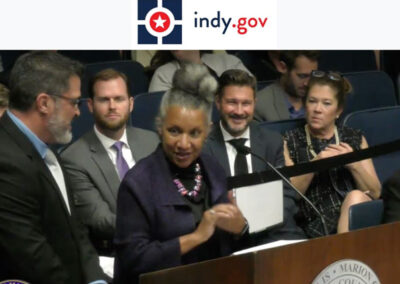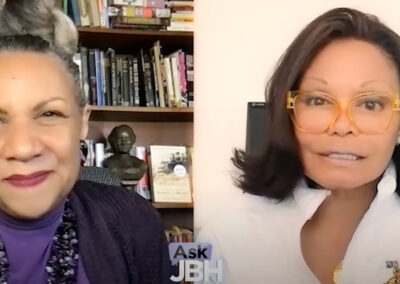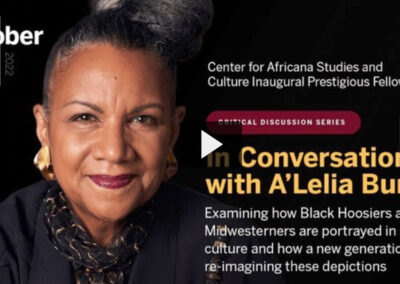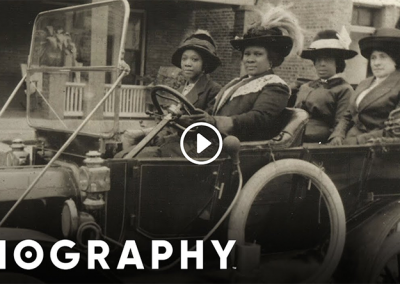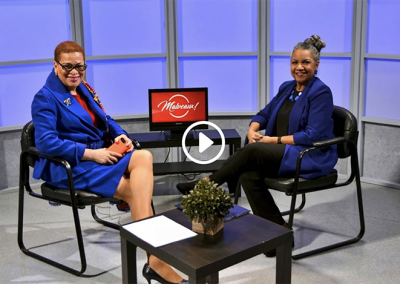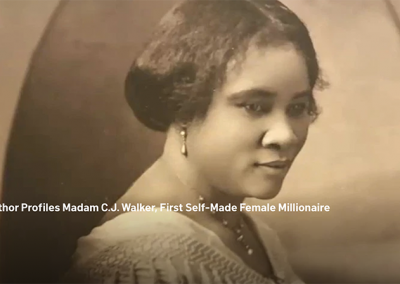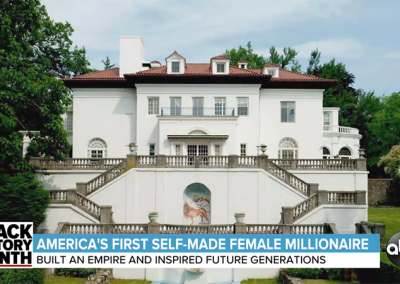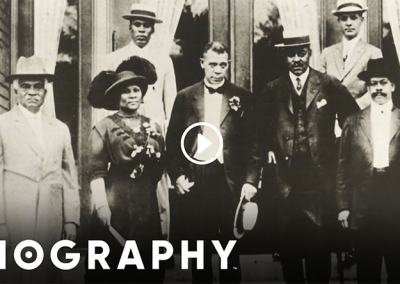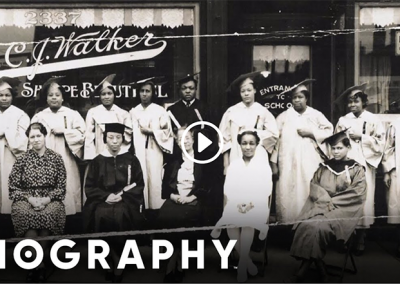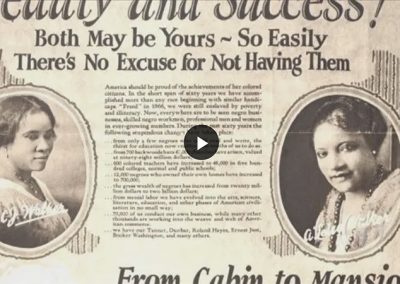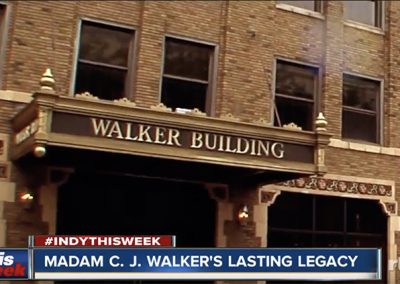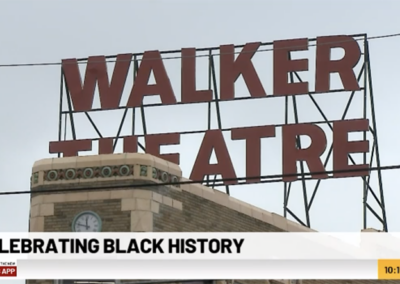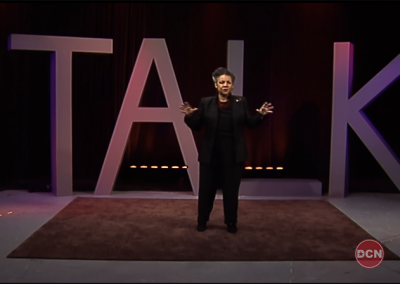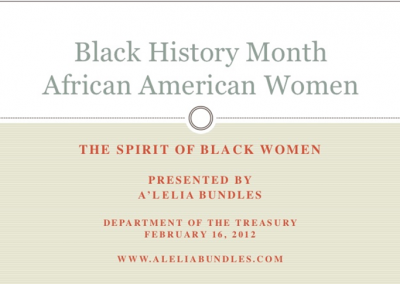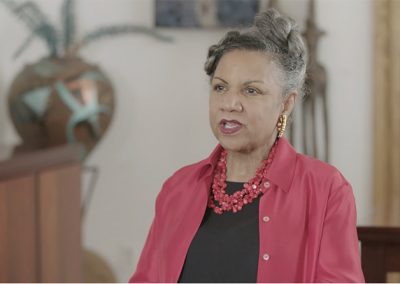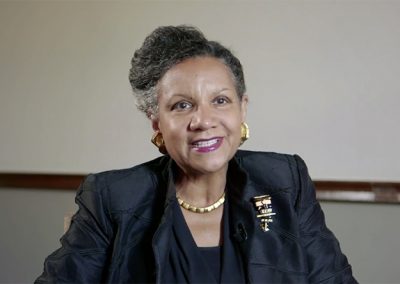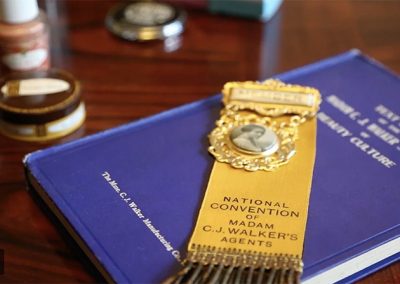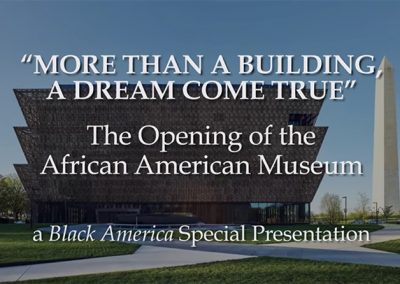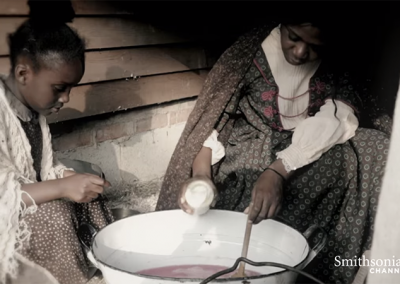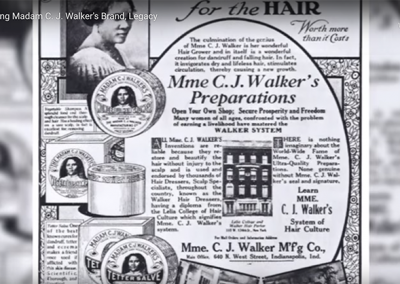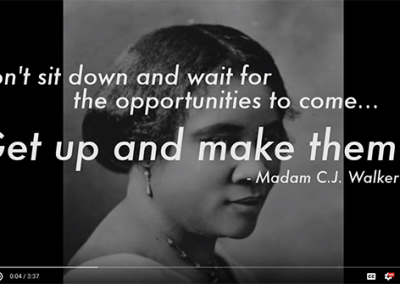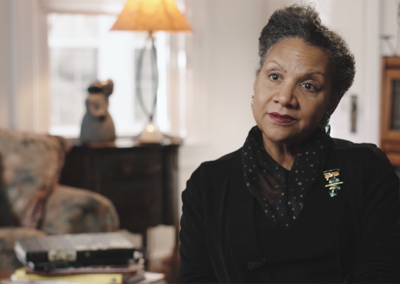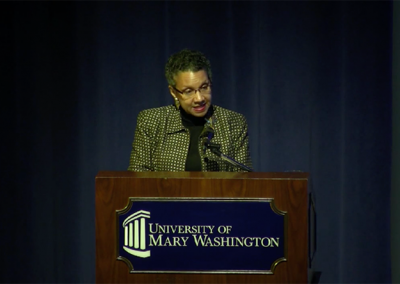About Madam C. J. Walker
“I am a woman who came from the cotton fields of the South. From there I was promoted to the washtub. From there I was promoted to the cook kitchen. And from there I promoted myself into the business of manufacturing hair goods and preparations….I have built my own factory on my own ground.”
Madam C.J. Walker
July 1912
Madam C.J. Walker: A Brief Biographical Essay
by A’Lelia Bundles
©2020
Learn more about Madam Walker from A’Lelia Bundles, her great-great-granddaughter and official biographer.
Sarah Breedlove–who later would come to be known as Madam C. J. Walker–was born on December 23, 1867 on the same Delta, Louisiana plantation where her parents, Owen and Minerva Anderson Breedlove, had been enslaved before the end of the Civil War. This child of sharecroppers transformed herself from an uneducated farm laborer and laundress into one of the twentieth century’s most successful, self-made women entrepreneurs.
Orphaned at age seven, she often said, “I got my start by giving myself a start.” She and her older sister, Louvenia, survived by working in the cotton fields of Delta and nearby Vicksburg, Mississippi. At 14, she married Moses McWilliams to escape abuse from her cruel brother-in-law, Jesse Powell.
Her only daughter, Lelia (later known as A’Lelia Walker) was born on June 6, 1885. When her husband died two years later, she moved to St. Louis to join her four brothers who had established themselves as barbers. Working for as little as $1.50 a day, she managed to save enough money to educate her daughter in the city’s public schools. Friendships with other black women who were members of St. Paul A.M.E. Church and the National Association of Colored Women exposed her to a new way of viewing the world.
Biography continued below…
Buy The Books
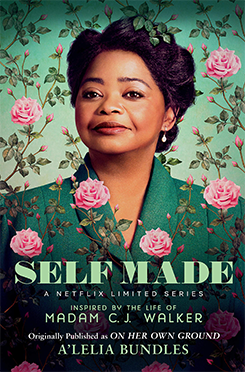
Self Made (Originally published as 'On Her Own Ground')

Madam Walker Theatre Center
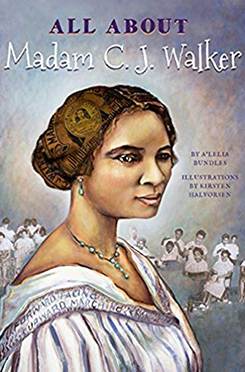
All About Madam C.J. Walker
During the 1890s, Sarah began to suffer from a scalp ailment that caused her to lose most of her hair. She consulted her brothers for advice and also experimented with many homemade remedies and store-bought products, including those made by Annie Malone, another black woman entrepreneur. In 1905 Sarah moved to Denver as a sales agent for Malone, then married her third husband, Charles Joseph Walker, a St. Louis newspaperman. After changing her name to “Madam” C. J. Walker, she founded her own business and began selling Madam Walker’s Wonderful Hair Grower, a scalp conditioning and healing formula, which she claimed had been revealed to her in a dream. Madam Walker, by the way, did NOT invent the straightening comb or chemical perms, though many people incorrectly believe that to be true.
To promote her products, the new “Madam C.J. Walker” traveled for a year and a half on a dizzying crusade throughout the heavily black South and Southeast, selling her products door to door, demonstrating her scalp treatments in churches and lodges, and devising sales and marketing strategies. In 1908, she temporarily moved her base to Pittsburgh where she opened Lelia College to train Walker “hair culturists.”
By early 1910, she had settled in Indianapolis, then the nation’s largest inland manufacturing center, where she built a factory, hair and manicure salon and another training school. Less than a year after her arrival, Walker grabbed national headlines in the black press when she contributed $1,000 to the building fund of the “colored” YMCA in Indianapolis.
In 1913, while Walker traveled to Central America and the Caribbean to expand her business, her daughter A’Lelia, moved into a fabulous new Harlem townhouse and Walker Salon, designed by black architect, Vertner Tandy. “There is nothing to equal it,” she wrote to her attorney, F.B. Ransom. “Not even on Fifth Avenue.”
Madam C.J. Walker
Learn More
A'Lelia Walker
Learn More
A'Lelia Bundles
Learn More
Walker herself moved to New York in 1916, leaving the day-to-day operations of the Madam C. J. Walker Manufacturing Company in Indianapolis to Ransom and Alice Kelly, her factory forelady and a former school teacher. She continued to oversee the business and to work in the New York office. Once in Harlem, she quickly became involved in Harlem’s social and political life, taking special interest in the NAACP’s anti-lynching movement to which she contributed $5,000.
In July 1917, when a white mob murdered more than three dozen blacks in East St. Louis, Illinois, Walker joined a group of Harlem leaders who visited the White House to present a petition advocating federal anti-lynching legislation.
As her business continued to grow, Walker organized her agents into local and state clubs. Her Madam C. J. Walker Hair Culturists Union of America convention in Philadelphia in 1917 must have been one of the first national meetings of businesswomen in the country. Walker used the gathering not only to reward her agents for their business success, but to encourage their political activism as well. “This is the greatest country under the sun,” she told them. “But we must not let our love of country, our patriotic loyalty cause us to abate one whit in our protest against wrong and injustice. We should protest until the American sense of justice is so aroused that such affairs as the East St. Louis riot be forever impossible.”
By the time she died at her estate, Villa Lewaro, in Irvington-on-Hudson, New York, she had helped create the role of the 20th Century, self-made American businesswoman; established herself as a pioneer of the modern black hair-care and cosmetics industry; and set standards in the African-American community for corporate and community giving.
Tenacity and perseverance, faith in herself and in God, quality products and “honest business dealings” were the elements and strategies she prescribed for aspiring entrepreneurs who requested the secret to her rags-to-riches ascent. “There is no royal flower-strewn path to success,” she once commented. “And if there is, I have not found it for if I have accomplished anything in life it is because I have been willing to work hard.”
Researchers: please cite this website and author information in your credits (“Madam Walker Essay” from www.madamcjwalker.com by A’Lelia Bundles).
These are some of the Frequently Asked Questions (FAQs) we get regarding Madam Walker's life. Please review these first. If you have a specific question that's not covered here, feel free to contact us.
What is fact and what is fiction in "Self Made," the Madam Walker Netflix series?
"Self Made," the Madam Walker Netflix series starring Octavia Spencer, is "inspired by" On Her Own Ground: The Life and Times of Madam C. J. Walker, a nonfiction, fact-based biography written by Madam Walker's biographer and great-great-granddaughter, A'Lelia Bundles, who is a journalist and former network television news producer and executive. Ms. Spencer embodies Madam Walker's courage and tenacity and conveys the challenges of building a successful business. But the Netflix series is a fictionalized version of Madam Walker's life with scenes that did not happen in real life and characters who were created or altered by the script writers in order to advance the story line they wished to present.
For the facts of Madam Walker's life, please read Self Made (originally titled On Her Own Ground). It is available in paperback as well as audiobook and Kindle. For the audio book go to Amazon.com and type "Self Made Madam Walker audio." For Kindle, type "Self Made Madam Walker Kindle."
Here are five sources that explain what is fact and what is fiction
National Trust for Historic Preservation/Saving Places Fact vs. Fiction
Indianapolis Monthly Behind the Scenes at "Self Made"
Bustle What Netflix Got Right and What It Got Wrong
Oprah Magazine What Self Made Got Right and Wrong
Elle How Much of Self Made Actually Happened
Here are three video interviews with A'Lelia Bundles
The Grio Interview with Keyaira Kelly
What is fact and what is fiction in "Self Made," the Madam Walker Netflix series?
"Self Made," the Madam Walker Netflix series starring Octavia Spencer, is "inspired by" On Her Own Ground: The Life and Times of Madam C. J. Walker, a nonfiction, fact-based biography written by Madam Walker's biographer and great-great-granddaughter, A'Lelia Bundles, who is a journalist and former network television news producer and executive. Ms. Spencer embodies Madam Walker's courage and tenacity and conveys the challenges of building a successful business. But the Netflix series is a fictionalized version of Madam Walker's life with scenes that did not happen in real life and characters who were created or altered by the script writers in order to advance the story line they wished to present.
For the facts of Madam Walker's life, please read Self Made (originally titled On Her Own Ground). It is available in paperback, audiobook and Kindle.
Here are five sources that explain what is fact and what is fiction
National Trust for Historic Preservation/Saving Places Fact vs. Fiction
Indianapolis Monthly Behind the Scenes at "Self Made"
Bustle What Netflix Got Right and What It Got Wrong
Oprah Magazine What Self Made Got Right and Wrong
Elle How Much of Self Made Actually Happened
Here are three video interviews with A'Lelia Bundles
The Grio Interview with Keyaira Kelly
When and where was Madam Walker born and how many siblings did she have?
Madam C. J. Walker was born Sarah Breedlove on December 23, 1867 in Delta, Louisiana where her parents and older siblings had been enslaved. The fifth of Owen and Minerva Anderson Breedlove’s six children, she was the first Breedlove child born after the end of slavery and the Civil War
Madam Walker had five siblings including one sister, Louvenia, and four brothers, Owen, Jr., Alexander, James and Solomon.
Where can I find a biography of her and learn what she accomplished?
A’Lelia Bundles, Madam Walker’s biographer and great-great-granddaughter, has written four books about her, including On Her Own Ground: The Life and Times of Madam C. J. Walker, which is the inspiration for "Self Made," the March 2020 Netflix series starring Octavia Spencer. She also has written several magazine articles and blog posts that appear on her website at http://www.aleliabundles.com/
Click here to read a brief biography of Madam Walker. You also can find video links on this site and on www.aleliabundles.com
The books are Self Made (originally published as On Her Own Ground: The Life and Times of Madam C. J. Walker), All About Madam C. J. Walker, Madam Walker Theatre Center: An Indianapolis Legacy and Madam C. J. Walker: Entrepreneur. You also can order audio books of Self Made and All About Madam C. J. Walker.
A'Lelia, who is a long time journalist and former producer and executive at ABC News, bases her books on factual information and extensive research.
When, where and how did Madam Walker die?
Madam Walker died on May 25, 1919 at 51 years old of kidney failure and other complications due to hypertension at Villa Lewaro, her Irvington-on-Hudson , New York estate. She was buried at Woodlawn Cemetery in the Bronx .
Was Madam Walker the first self-made American woman millionaire? Was she the first African American millionaire?
Madam Walker is listed in the Guinness Book of World Records as the first self-made American woman millionaire, who neither inherited her money or married someone who was a millionaire. At the time of her death, Madam Walker’s estate had an estimated value of $600,000 to $700,000 (equivalent to approximately $8.9 million to $10.4 million in 2020 dollars according to the CPI Inflation Calculator). The total sales of her company, the Madam C. J. Walker Manufacturing Company, during the final year of her life reached more than $500,000, making the value of her company several times that amount. The combination of her personal assets (real estate, furnishings, jewelry, etc.) and the value of her business was well over $1,000,000 (equivalent to $14.9 million in 2020).
It is important to note that other wealthy African Americans—including Robert R. Church, Sr. (1839 – 1912) of Memphis , Mary Ellen Pleasants (1814-1903) of San Francisco , Bridget “Biddy” Mason (1818-1891) of Los Angeles and Annie Malone (1877 – 1957) of St. Louis —have also been described in other sources as millionaires but there is not the same level of documentation for the wealth of these individuals. William Leidesdorff (1810 – 1848), who was of black, Jewish and Caribbean ancestry, is considered the first African American millionaire and was said to have been the wealthiest man in San Francisco at the time of his death.
There are some people who claim that Annie Malone, Madam Walker's business competitor, became a millionaire before Madam Walker, but the historical record does not support this claim. Here is an article with more details: "The Facts about Madam Walker and Annie Malone"
Documents detailing Madam Walker’s wealth are in the Madam Walker Collection at the Indiana Historical Society.
What kind of education did Madam Walker have?
Madam Walker received very little formal education as a child, except possibly at her family’s small church in Delta, Louisiana where Reverend Curtis Pollard—a black man who had served as a Louisiana state senator during Reconstruction—was the minister. Sadly, by the time young Sarah Breedlove was old enough to attend school in the early 1870s, the white legislators refused to provide funds for the education of black children in Louisiana . After the death of her parents when she was only seven years old, Sarah had to work to help support the household where she lived with her sister and brother-in-law.
Later, when she and her young daughter moved to St. Louis in the late 1880s, she had some opportunity to improve her reading and writing skills with the assistance of the women in her church, St. Paul AME. Years later, she would say that she had attended night school in St. Louis as she was starting her business.
As Madam Walker was becoming a successful businesswoman, she hired Alice Kelly, who had been at teacher at a school in Kentucky , to be her private tutor so that she could enhance her education.
In large part, Madam Walker was a self-educated woman because of the circumstances of her time.
Where can I find photos of Madam Walker? Where can I find the most reliable information about Madam Walker?
A’Lelia Bundles, Madam Walker’s great-great-granddaughter and biographer, is president of the Madam Walker/A’Lelia Walker Family Archives, the largest private collection of photographs, Walker Company business and legal documents, personal letters, furniture, clothing and personal Walker family items. She is a former board member of the Madam Walker Theatre Center, the National Historic Landmark that honors Walker’s legacy today. This website is the most reliable and comprehensive website with information about Madam Walker’s life. Originally created in 1998, it frequently is updated by A’Lelia Bundles.
A’Lelia’s book, On Her Own Ground: The Life and Times of Madam C.J. Walker, was the first truly comprehensive biography of Walker and has been honored as a New York Times Notable Book, a Black Caucus of the American Library Association Honor Book, the Association of Black Women Historian’s Letitia Woods Brown Book Prize as the 2001 best book on black women’s history and a Hurston-Wright/Borders Books Legacy Finalist. A’Lelia continues to honor her family’s legacy through books, speeches and research. Visit her website at www.aleliabundles.com for more information about photos and primary source documents.
Where did Madam Walker live? How many times was she married and to whom?
Madam Walker was born in Delta, Louisiana. Around 1878 she and her sister are believed to have moved across the Mississippi River to Vicksburg , Mississippi . After the death of her first husband, Moses McWilliams, she and her two year old daughter moved to St. Louis , where her brothers had established themselves as barbers. In 1905 after the death of her brothers and her separation from her second husband, John Davis, she moved to Denver , where she lived from July 1905 to September 1906 when she began a year of travel to promote her new company. While in Denver, she married her third husband, Charles Joseph Walker. From 1908 until early 1910 she lived in Pittsburgh , where she opened the first Lelia College of Beauty Culture to train Walker agents and “hair culturists.” In February 1910 she moved to Indianapolis , Indiana where she built a factory and expanded her business. Although Madam Walker moved her residence to New York in 1916, the headquarters of the Madam C. J. Walker Manufacturing Company remained in Indianapolis for more than seven decades.
I am writing a report. Where can I find primary source documents about Madam Walker?
The Madam Walker/A’Lelia Walker Family Archives is the largest privately owned collection of Walker personal letters, business records, photographs, clothing, furniture and Walker memorabilia. Click here to contact Walker’s great-great-granddaughter, A’Lelia Bundles, for primary sources documents from the Archives
The Madam Walker papers are located at the Indiana Historical Society Library in Indianapolis . For more information click here where you can learn more about the 40,000 digitized items from the Madam Walker Collection and the Madam Walker exhibit. You also can call 317-232-1879.
You can click here for a bibliography of Madam Walker related books, articles and other materials.
We also hope you will visit the main branch of your local public library to consult black newspapers from the early 1900s and that you ask the librarian if there are any archival materials about the black community in your town or city. Major manuscript collections of other famous African Americans who knew Madam Walker exist at the Library of Congress, at Howard University ‘s Moorland Spingarn Collection in Washington , D.C. and at the Schomburg Center for Research in Black Culture in New York City . We recommend that you not rely solely on the Internet for your research because there is a great deal of inaccurate information about Madam Walker on the Internet.
The Library of Congress also has a list of sources about Madam Walker.
I have seen fictional accounts, novels and other biographies about Madam Walker. Do these sources contain reliable information?
We recommend the nonfiction biographies about Madam Walker by A’Lelia Bundles, her biographer and great-great-granddaughter. On Her Own Ground: The Life and Times of Madam C. J. Walker (Scribner, 2001) is a comprehensive, historically accurate biography of Madam Walker. All About Madam C. J. Walker (Cardinal Publishers) is written for young adult readers (approximately fourth grade through seventh grade). For early elementary school readers we recommend Vision of Beauty by Kathryn Lasky. If you are seeking accurate information about Madam Walker, we do not recommend any of the novels, which are fictional works.
Among the non-fiction books we recommend are Beauty Shop Politics by Tiffany Gill, Hair Raising by Noliwe Rooks, Hope in a Jar by Kathy Peiss and Madam Walker's Gospel of Giving by Tyrone McKinley Freeman.
We also recommend "BOSS: The Black Experience in Business," a non-fiction documentary film directed by Stanley Nelson.
"Self Made," the 2020 Netflix series, is a Hollywood version of Madam Walker's life and includes many characters who did not exist as well as relationships and scenes that are exaggerated or made up. The series has done a great job of making more people aware of Madam Walker's life. It dramatically illustrates Madam Walker's tenacity and and in a general sense shows the struggles she faced in building her business, but viewers should not assume that the scenes and characters are historically and factually accurate.
Is there a Madam Walker museum? Where can I find Walker photos, artifacts and memorabilia? Where can I find Walker items for sale?
Madam Walker’s great-great-granddaughter, A’Lelia Bundles, is president of the Madam Walker/A’Lelia Walker Family Archives, the largest private collection of inherited and acquired Walker photographs, business records, correspondendence, clothing, furniture and personal artifacts belonging to the Walker family. She can be reached at www.aleliabundles.com.
You can purchase Madam Walker t-shirts, postcards and other items at the Madam Walker Gift Shop
There are two National Historic Landmarks associated with Madam Walker. The Madam Walker Legacy Center in Indianapolis, Indiana, which was home to the Madam Walker Manufacturing Company from the late 1920s until the mid-1980s, is open to the public.
Villa Lewaro, Madam Walker’s Irvington-on-Hudson , New York mansion, is a private residence and not currently open to the public. Click here and here to learn more.
The Indiana Historical Society opened a major Madam Walker exhibit -- "You Are There: Madam Walker 1915" -- which will be up from September 2019 through January 2021.
What awards did Madam Walker receive?
Madam Walker has received much posthumous recognition as an inductee into the National Business Hall of Fame at the Museum of Science and Industry in Chicago, the National Women’s Hall of Fame in Seneca Falls, New York, the American Health and Beauty Aids Institute Hall of Fame in Chicago ( www.ahbai.org ) and the Black Wax Museum in Baltimore. She received a Distinguished Service Award from The Direct Selling Association. She has been cited by the Harvard Business School as one of the “great American business leaders of the twentieth century.”
Madam Walker was honored in 1998 with a U. S. postage stamp as part of the Black Heritage Series.
Her Irvington-on-Hudson , New York home—known as Villa Lewaro—as well as the Madam Walker Theatre Center in Indianapolis are National Historic Landmarks. Villa Lewaro also is a National Trust for Historic Preservation National Treasure.
Today many organizations and institutions present awards named after Madam Walker.
Thanks to Grace Stiles of the Stiles Heritage Center in Denver, there is a Madam Walker Parkin the Denver.
Did Madam Walker invent the straightening comb or the perm?
No, Madam Walker did NOT invent the straightening comb or the perm. This erroneous claim seems to have originated during the 1920s after Madam Walker’s death when the officers of the Madam C. J. Walker Manufacturing Company purchased a patent for a metal comb from person who had supplied combs to Madam Walker during her lifetime. While much more research is required to determine which person or persons actually created the first straightening comb, there is evidence that such hair care implements were available at least as early as 1872 when Francois Marcel Grateau perfected his Marcel Wave in France. For more information about Grateau click here. Also read Linda Jones’s article "Dispelling a Hairstorical Myth" on NaturallyCurly.com and read the Wikipedia page about hot combs.
Metal hot combs were sold in Sears and Bloomingdales catalogs during the 1880s to a predominantly white clientele.
Madam Walker can be said to have been one of the people who “popularized” the use of the hot comb among black women because she taught many women how to use it, but she did NOT invent it. Her original products were designed more to cleanse the scalp and hair, heal scalp disease and prevent dandruff and baldness rather than to straighten hair. Contrary to popular belief, Madam Walker did not invent perms and did not use the words “hair straightener” in her advertisements.
What were Madam Walker’s original products? And why do I see different spellings for Madam?
Madam Walker’s five original products were Madam Walker’s Wonderful Hair Grower, Temple Salve, Tetter Salve, Vegetable Shampoo and Glossine. When Madam Walker began her company, there were very few products on the market specifically for black women, so her products were quite unique. Today there are thousands of products and many new innovations and advances in caring for African American women’s hair. In a significant new development Sundial Brands — manufacturers of Shea Moisture and Nubian Heritage — introduced a newly formulated line of Madam Walker products in the spring of 2016. For more info follow them at @mcjwbeauty on Twitter.
A’Lelia Bundles, Walker’s great-great-granddaughter and biographer, hosts the Black Hair Historian Facebook page where she posts information about the history of hair care.
Madam Walker originally spelled her title with no “e.” On our website’s timeline, you will see an image of her original product, Madam Walker’s Wonderful Hair Grower. To be historically accurate, we spell Madam without an “e.”
(These are variations on the spelling: Madame Walker Hair Care Products. Mme. C. J. Walker Hair Care Products. Madame Walker Products. Madame Walker Hair Care. Mme. Walker. Madame Walker. But the historically accurate spelling is “Madam C. J. Walker”)
My hair is falling out? What can I do?
We recommend that you schedule an appointment with a dermatologist to determine the cause of your hair loss. Many people over-process their hair with chemicals, wear styles that are too tightly braided, wash their hair infrequently or otherwise abuse their hair. Sometimes the problem is more related to illness, medical treatments, stress or diet. Consulting a health care professional is an important first step. Click here for more information.



Madam Walker Legacy Center
The Madam Walker Legacy Center engages diverse audiences and promotes creativity in entrepreneurial and artistic expression.
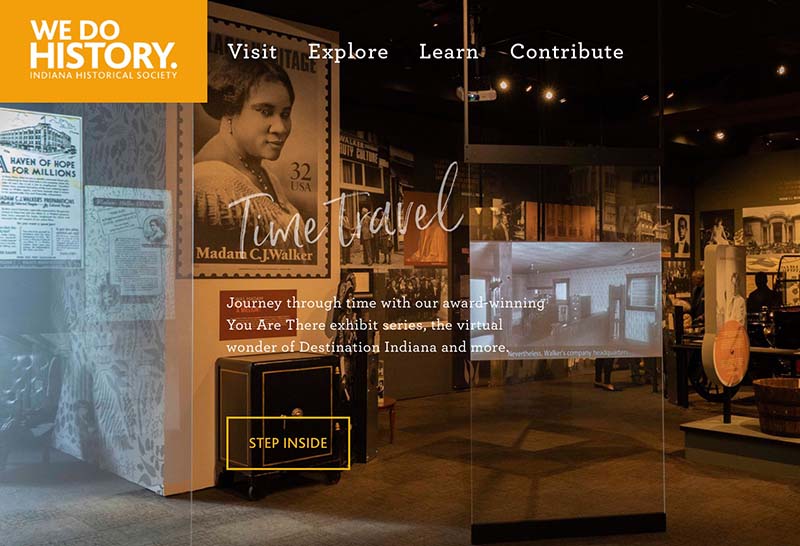
Indiana Historical Society
The Madam Walker Collection is located at the Indiana Historical Society Library in Indianapolis, Indiana. It contains extensive primary source documents abut Madam Walker's life and business.


